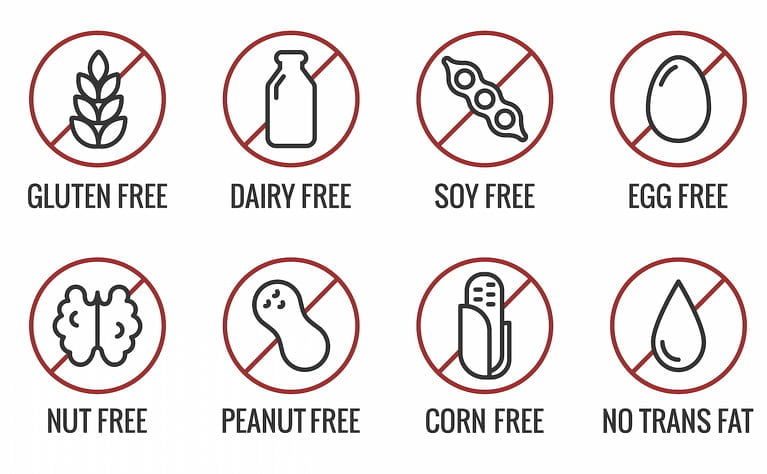
Three At-Home Strategies to Identify Food Triggers
A growing list of methods are proving beneficial for helping those with digestive distress get to the bottom of foods that are causing aggravation.
Food journaling is an effective tool that can help you make connections about what’s causing digestive distress.
By Amy Denney
11/25/2023
Burping, bloating, esophageal burning, and varying degrees of pain—these are some typical after-meal experiences for people with digestive issues.
Some people know what foods will bring on symptoms, but for others, the cause of their gastro-distress remains a mystery. Fortunately, if your struggle involves digestive distress and not severe or life-threatening allergic responses—which require immediate medical attention—you might be able to do a little detective work and learn more about how your body is responding to food. You may even be able to pinpoint the specific foods that are causing the issues.
Newer self-directed methods to determine food reactions are growing in popularity, in part because studies indicate that they work.
However, the first hurdle is acknowledging that food is associated with symptoms—something your doctor may overlook. Oftentimes, it’s patients themselves who make the connection.
Nicola Solomonides, who was diagnosed with Crohn’s disease in 2001 at age 17, was told that food wasn’t a factor. Crohn’s is one type of inflammatory bowel disorder (IBD). Her symptoms escalated to the point of needing major surgeries and having colon cancer.
“For years I was told that diet didn’t make a difference, but it certainly didn’t feel that way to me,” she told The Epoch Times. “The goal should always be to learn to listen to your body and what it’s telling you.”
The Growing Problem of Food Reactions
Only in the past decade has research begun to connect IBD to food allergies and nonallergic food reactions. Research also shows that food sensitivities and allergies are increasing, leaving more people struggling with food in ways that affect digestion and overall wellness.
Food allergies now affect about 10 percent of the population, according to a 2019 study in JAMA Network Open. The investigation noted that nearly twice that many adults believe that they have food allergies, reflecting the parallel proliferation of food intolerances and food sensitivities, as well as the confusion between all three.
A true food allergy is a reaction driven by the immune system mistaking food as an invader and releasing antibodies called immunoglobulin E (IgE) to fight it. Allergies cause symptoms such as hives, wheezing, and shortness of breath within minutes of eating the offending food. In some cases, food may cause anaphylaxis, a severe reaction that can be fatal if not treated rapidly with epinephrine.
Symptoms of food sensitivities may not show up for hours or even days, and the mechanism is poorly understood, although it’s believed to be an immune-related response. Food intolerances are described by the Global Autoimmune Institute as a “functional response to food molecules” that often involves a deficiency in a digestive enzyme needed to break down food.
The terms “food intolerances” and “food sensitivities” are sometimes used interchangeably and research suggests that they may be connected to deficiencies in the gut microbiome—the community of bacteria, viruses, and fungi that assist the body with digestion, immunity, and all sorts of functions.
One role of the microbiome is to fortify the intestinal lining so that only the correct molecules will be absorbed into the body. One theory behind the rise in food sensitivities is that the gut is becoming damaged by toxins in our food and environment that punch holes in the lining, sometimes referred to as “leaky gut.” This may allow bacteria and partially digested food proteins to wander into the bloodstream, where they don’t belong, and cause a systemic autoimmune reaction.
Food intolerances and sensitivities typically cause mostly digestive symptoms such as abdominal pain, diarrhea, gas, bloating, migraines or headaches, heartburn, nausea, and upset stomach, according to the Cleveland Clinic.
Food Response Testing
There are a variety of tests that claim to diagnose food allergies and sensitivities. While IgE tests have been clinically validated for allergies, other types of testing for nonallergic reactions are more confusing and controversial.
A 2018 study notes that it isn’t understood why the human immune system doesn’t consistently mount an immune response to food, considering it’s all “foreign” to the body.
“Guidelines sponsored by the National Institute of Allergy and Infectious Diseases note that diagnosing non-IgE-mediated immunologic adverse reactions to food can be challenging, and many immune cells may be involved in the pathogenesis of non-IgE-mediated food reactions,” wrote the authors of the research, which was published in Nutrition and Metabolism.
They used leukocyte activation tests to see what food would release DNA. Several diseases are believed to be activated by cell-free DNA, which is associated with cell die-off and regeneration—a natural part of cell turnover. However, a high volume of circulating cell-free DNA appears to indicate a disease state, and the study proposes that released DNA’s association with specific foods can guide dietary choices and lead to better health.
While some research on leukocyte activation shows that it isn’t reproducible, a blinded, randomized controlled trial of irritable bowel syndrome (IBS) patients found that the test-guided dietary changes did lead to significant symptom improvement. The test is called an ALCAT, and neither it nor another popular food sensitivity method, food-specific immunoglobulin G (IgG), is without controversy.
ALCAT and IgG tests can be ordered at various online labs.
IgG testing looks at whether certain antibodies are formed against food. Dr. Sara May, Nebraska Medicine allergy and immunology specialist, argues that IgG antibodies demonstrate tolerance—not intolerance—to food.
“As a result, you may end up with test data that shows a high IgG for many types of foods,” she said in a statement. “However, there is no research that shows that IgG positivity correlates to intolerance. Due to tests like these, I often have people come to my office with very restricted diets based on their test results and continue to suffer from abdominal symptoms.”
Breath Testing
Hydrogen breath tests are a clinically validated way to assess certain gastrointestinal disorders such as lactose intolerance and small intestinal bacterial overgrowth (SIBO), as well as to rule out these two conditions along the way to uncovering an IBS diagnosis.
The tests, available through doctors and at home, measure hydrogen gas levels in your breath. Newer tests also measure methane. Gas is created by fermentation—gut bacteria digesting sugars and carbohydrates. It moves into the lungs and can be detected by the test.
Breath tests offer definitive evidence about lactose intolerance, small intestinal bacterial overgrowth, and irritable bowel syndrome. (Shutterstock)
In a healthy person, sugars and carbohydrates are predigested before making their way to the colon. If these foods make it to the colon undigested, bacteria there are forced to digest them, and they convert them into gas, which is responsible for uncomfortable symptoms such as bloating, pain, flatulence, and inconsistent bowel habits. In the case of SIBO, bacteria that don’t belong in the small intestine are fermenting these foods.
Breath tests involve a variety of preparations and potentially require several rounds of testing to check whether you’re reacting to lactose, sucrose, fructose, sorbitol, or glucose. However, there’s a newer breath test that can test for these at home, as well as offering unlimited immediate feedback on specific foods. The test can be taken several times throughout the day.
A 2019 study published in Nutrients illustrated that this portable consumer device, called AIRE, can help identify problematic foods. It links to an app—which also allows for tracking of food, stress, sleep, and bowel movements—that provides daily insights and trends over time.
Dr. William Davis, cardiologist and author of “Super Gut,” told The Epoch Times that he uses the AIRE device to verify whether strategies to eradicate SIBO are working. The goal shouldn’t be to indefinitely eliminate food, he said.
“You remove the food from the diet, you reduce symptoms, but it doesn’t fix the problem,” Dr. Davis said.
The study in Nutrients also states that behavior changes involving food avoidance aren’t necessarily good and can lead to nutrient deficits. FODMAPs—which stands for fermentable oligosaccharides, disaccharides, monosaccharides, and polyols—are associated with unpleasant abdominal symptoms for a large number of people. Yet a diet without them is also linked to low levels of beneficial bacteria, such as Bifidobacteria, and an abundance of harmful bacteria such as Porphyromonadaceae.
Connecting the Dots With Food Journaling
A more simplistic and straightforward strategy for identifying food triggers is food journaling, sometimes used in conjunction with testing, low-FODMAP diets, or elimination diets.
A 2019 study in Clinical and Translational Gastroenterology noted that a food diary could help patients with IBS determine how their symptoms correspond to their diet. In particular, 51 New Zealand study participants experiencing diarrhea discovered that eating a diet high in FODMAPs was associated with bloating. And those with constipation found that fiber was linked to their fullness and bloating.
The Functional Nutrition Alliance describes its “food-mood-poop” journal as its top tool for helping clients collect information for healing a plethora of conditions. It offers a template on its website.
Ms. Solomonides, whose own experience with the healing power of food led her to become an instructor and coach through the Academy of Culinary Nutrition, is a big proponent of food journals and assists her clients in using them.
The key, she said, is to make it work for you. For instance, some people like to add entries for sleep, stress, exercise, and more—but if it feels too overwhelming, just focus on the essentials.
Some of the biggest discoveries that Ms. Solomonides made through food journaling include the following:
- Some vegetables can be tolerated cooked, even if they cause symptoms when eaten in raw form.
- Reactions might be related to eating too much of one particular food. For instance, a small serving of chickpeas versus a large bowl.
- Journaling may not give you all the answers, and it’s not really designed to.
- Tracking can be useful as a long-term tool or even just for a short period of time to pick up on patterns.
- Food sensitivities and reactions can change.
- It’s about observation, not obsession.
Food journaling is an important way that people with digestive issues can start to identify patterns between symptoms and food.
“Use it to help you learn and figure things out, but then aim to eat as intuitively as possible without it, using what you’ve learned and listening to your body now that you’re better equipped to understand its symptoms,” Ms. Solomonides said.

